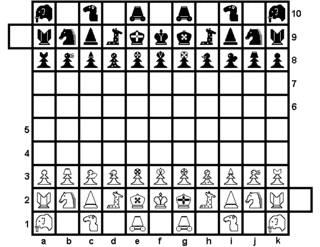
- Chess World Cup
- FIDE Grand Prix
- Olympiad
- World Championship
- List of strong tournaments
- List of world championships

- Checkmate patterns
- Chess openings
- Chess strategy
- Chess tactics
- Chess theory
- Endgames
- Pawn structure
- Problems/Compositions












 Tamerlane chess starting board
Tamerlane chess starting boardTamerlane chess is a strategic board game related to chess and derived from Chaturanga. It was developed in Persia during the reign of Timur, also called Tamerlane (1336-1405). Some sources attribute the game's invention to Timur, but this is by no means certain. Because Tamerlane Chess is a larger variant of Chaturanga, it is also called Shatranj Kamil (perfect chess) or Shatranj Al-Kabir (large chess). It is distinctive in that there are multiple varieties of pawn, each of which promotes in its own way.
A Tamerlane chess board is made up of 110 uncheckered squares arranged in a 10x11 pattern. Additional squares protrude from the left side on the ninth row and from the right side on the second row. These extra squares are called citadels. When the opposing king occupies a player's citadel, the game is declared a draw. No piece other than a king may occupy a citadel.
There are several ways for an opening setup to be arranged. A common one is as follows:
Black's side mirrors white's.
Anglicised versions of piece names are used here.
Upon reaching the last rank on the board, a pawn is promoted to its corresponding piece. Thus, Pawn of Giraffes becomes a Giraffe, etc. Exceptions to this are the Pawn of Kings and Pawn of Pawns. A Pawn of Kings becomes a Prince, which must be mated or taken before the opponent can win. It moves as a king.
When the Pawn of Pawns reaches the last rank, it stays there and cannot be taken. As soon as a situation develops where the opponent cannot escape losing a piece to a pawn, or where a pawn may attack two opposing units at the same time, the player must move his/her pawn to that location. Upon the second promotion of this pawn, it moves to the starting point of the Pawn of Kings. Upon the third promotion it becomes an adventitious king, which acts as a prince.
When multiple kings are held, they may be captured as normal pieces. When only one king remains it must be checkmated. Once during the game a player may exchange a checked king for another non-royal piece. A player may move into check if he holds multiple kings. The adventitious king is the only piece that may move into a player's own citadel. This is often done to prevent the opponent from entering.
Gollon, John. (1973). Chess Variations: Ancient, Regional, and Modern. Charles E. Tuttle Co., Inc., RR1 Box 231-5, North Clarendon, VT 05759-9700, USA. ISBN 0-8048-1122-9.